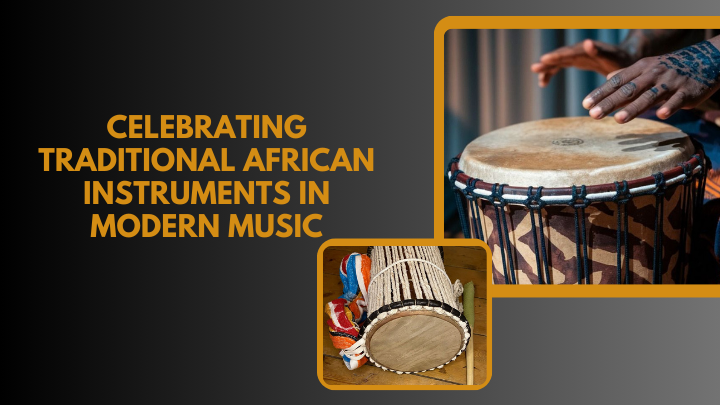Traditional African Instrument in Modern Music
African music is a rich tapestry of diverse rhythms, melodies, and instruments, each rooted in the continent’s unique cultures and traditions. While the global popularity of modern African music genres like Afrobeats, Amapiano, and hip-hop has garnered significant attention, traditional African instruments continue to play a pivotal role in shaping the sound of contemporary African music. Instruments like the djembe, kora, balafon, and many others are being fused with modern sounds, creating a dynamic blend that respects cultural heritage while embracing innovation. In this article, we celebrate the role of traditional African instruments in today’s music scene and explore how they continue to influence and shape the future of African music.
1. The Djembe: The Heartbeat of African Rhythms
One of the most iconic instruments in African music, the djembe drum, originates from West Africa, particularly the Mandingue people in countries like Mali, Guinea, and Senegal. Known for its rich, deep tones and sharp, high-pitched slaps, the djembe has long been a symbol of African cultural identity. Traditionally, the djembe was used in ceremonial settings, storytelling, and social gatherings, where its rhythms would convey important messages and emotions.
In today’s music, the djembe has found its way into a wide variety of genres, from Afrobeat to hip-hop, jazz, and pop. Modern African artists like Burna Boy, Wizkid, and Yemi Alade often incorporate djembe rhythms into their tracks, infusing their music with a sense of cultural authenticity and energy. The drum’s rhythmic complexity adds a raw, organic layer to modern productions, helping to bridge the gap between traditional African sounds and contemporary styles.
International collaborations have also played a major role in bringing the djembe to a global audience. Musicians like Alicia Keys, Usher, and even global groups like U2 have worked with African percussionists, using the djembe to enhance the rhythm and emotional depth of their songs. As the djembe’s signature beats continue to reverberate across genres, its place in modern African and global music remains unshakable.
2. The Kora: The “Harp of West Africa”
The kora, a 21-stringed harp-lute traditionally played in West Africa, is one of the continent’s most ancient and revered instruments. Often associated with the griot tradition in countries like Senegal, Mali, and Guinea, the kora is a symbol of storytelling, history, and cultural preservation. The instrument’s complex and melodic sound is produced by plucking its strings with the fingers, creating a resonant, soothing tone that can evoke deep emotions.
In the contemporary music scene, the kora has been embraced by artists looking to blend African tradition with modern genres. The instrument’s ethereal tones have been incorporated into a range of music, including jazz, world music, and even electronic genres. One of the most prominent kora players, Toumani Diabaté, has collaborated with international musicians like Ali Farka Touré and the British band, Keziah Jones, showcasing how the kora can transcend cultural boundaries.
Kora music has also found its way into popular African music, with artists like Baaba Maal, Amadou & Mariam, and Angelique Kidjo utilizing its unique sound to infuse their songs with the rich cultural heritage of West Africa. The instrument’s ability to add a sense of depth and storytelling to modern songs has made it an indispensable tool in creating the fusion of old and new in today’s African music.
3. The Balafon: Africa’s Vibrant Xylophone
The balafon is a traditional West African percussion instrument similar to a xylophone, made up of wooden slats placed over gourds that act as resonators. The sound of the balafon is melodic and bright, creating a lively and rhythmic atmosphere. It is widely used in Mali, Guinea, and Burkina Faso, where it is an essential part of ceremonial and celebratory music.
In contemporary African music, the balafon’s distinctive sound is often used to complement and enrich modern compositions. Its percussive yet melodic nature makes it a perfect match for genres like Afrobeats, reggae, and jazz, where rhythm plays a central role in the music’s drive and flow. Artists like Salif Keita, Toumani Diabaté, and Oumou Sangaré have embraced the balafon in their music, bringing its rich, vibrant tones to global audiences.
The rise of Afrobeats and other fusion genres has also allowed the balafon to take center stage in contemporary productions. By combining the balafon with modern electronic beats and synthesized sounds, artists are able to create fresh, innovative tracks that still maintain the cultural essence of traditional African music.
4. The Ngoni: A Traditional Lute with Global Appeal
The ngoni is a traditional West African stringed instrument that is similar to a lute. It has been used for centuries by griots and other musicians to accompany storytelling and historical songs. The ngoni has a rich, resonant sound that adds depth to African folk and traditional music, making it a cornerstone of West African musical traditions.
Today, the ngoni is making its mark on modern African music, especially in genres like Afrobeat and world music. Artists such as Ali Farka Touré and Bassekou Kouyaté have used the ngoni to create a fusion of traditional Malian sounds with modern influences. The ngoni’s unique tonal qualities have been embraced by artists worldwide, creating an opportunity for this ancient instrument to be recognized on the global stage.
Incorporating the ngoni into modern African music allows for a seamless blend of past and present, showing how traditional instruments can remain relevant while appealing to global audiences.
5. The Shekere: The Percussive Jingle of West Africa
The shekere, a percussion instrument made from a gourd covered with a net of beads or shells, is often used in West African music. The instrument’s rhythmic jingle and shaking sound add texture and energy to African dance music. Traditionally, the shekere was used in ceremonies, rituals, and festivals, but in modern times, it has become a symbol of the festive, high-energy spirit that African music represents.
In contemporary African music, the shekere is commonly found in the backgrounds of Afrobeats, reggae, and pop songs. It helps to maintain the energy and drive of the music while adding a distinctive, traditional flavor. Artists like Fela Kuti, Olamide, and Yemi Alade have used the shekere in their tracks, keeping the instrument alive in the modern African music scene.
6. The Influence of Traditional Instruments on Global Music
As African music continues to gain international recognition, the influence of traditional instruments is evident in the way artists blend them with global genres like pop, jazz, electronic music, and hip-hop. Traditional instruments like the djembe, kora, balafon, ngoni, and shekere have become integral to the fusion of African music with global sounds, bringing the richness of African heritage to the world stage.
Collaborations between African and international artists continue to showcase the versatility and global appeal of these instruments. Whether in jazz compositions, world music performances, or pop collaborations, traditional African instruments provide an authentic sound that resonates with audiences everywhere.
The Ongoing Celebration of African Heritage
Traditional African instruments are more than just cultural relics—they are living, breathing parts of today’s musical landscape. As African music continues to evolve, the role of instruments like the djembe, kora, balafon, and others remains vital. These instruments not only preserve the continent’s rich musical heritage but also ensure that African music stays dynamic, relevant, and impactful in the global music scene. As modern artists continue to experiment and innovate, the sounds of these traditional instruments will undoubtedly remain an essential part of the story, bridging the gap between Africa’s past and its vibrant musical future.



